![]()
Tripod Head
‘Tripod heads’, are normally fixed on the top platform of a tripod. The head allows you to fix the camera onto the tripod but gives you the flexibility you need to change the camera position. This provides freedom of movement for the camera so you do not have to keep moving or adjusting the tripod legs.
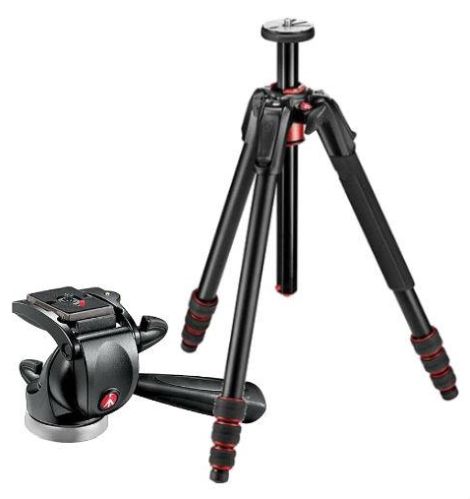
If you own a quality tripod, there will be a platform to fit your tripod head upon. The tripod head allows the camera to be positioned in any of three dimensions.
No head, no flexibility
A camera on a tripod without a tripod head fixes the camera in an immovable position. Like that, you can only adjust the legs to set the camera position. This makes setting the camera to the right attitude time-consuming, difficult and unwieldy.
Quality engineering is essential
The tripod head can lock the camera in different positions for each shot. Your tripod head allows full movement of the camera through three dimensions – right or left and up or down. You will find a lock of some sort will act to fix the tripod head in its position while you take the shot. Most tripod heads let you flip your camera onto its side too. This orientation will change your view from a landscape view to a portrait view.
Using the position locks on the head you can readily tighten or loosen the camera mount. This gives you the ability to quickly re-position the camera for your next shot. You should not need to adjust the tripod legs for most shots.
If you have experienced a poor quality tripod head, you will know how frustrating it can be. Sloppy fittings, movement and poor accuracy all add up to poor shots. So look out for quality engineering when you buy a tripod head. The investment will be well made if you choose the right head for your interests.
Panning and tilting
Any left or right movements of the camera are called panning. When you make vertical camera movements (up/down) you call that ’tilting’ (to tilt). Both panning and tilting are essential to good camera positioning. However, good tripod heads are designed to make panning as easy as possible. As you develop your skills, panning becomes an essential and important technique.
Fitting the tripod head
Your tripod top platform should have one of two standard screw sizes. They are a 1/4 inch by 20 screw (1/4 inch thread with 20 threads per inch), or 3/8-16 screw (3/16 inch thread with 16 threads per inch). You use these to mount the head on the tripod. The tripod head itself, will have a similar mounting to fix the camera. Tripod heads often have “quick release” plates. These handy devices stay screwed to your camera. The plate allows you to quickly slot the camera into your tripod head and click fasten it down. They also usually have a quick release mechanism. Then you can quickly release your camera from the tripod head.
There are a huge variety of tripod head designs and mechanisms on the market. It is beyond the scope of this article for me to describe them all. Suffice to say, that not all tripod heads are suitable, or even feasible, for some types of photography. So, I advise you to seek professional advice on your needs before buying a tripod head. While they can be expensive, wise investment will give you years of effective use.
Tripod heads fall into a few general categories:
Ball heads:
This type of tripod head uses a ball and socket arrangement. You can pan, tilt or flip the camera around the axis of rotation on the ball. The mechanism is simple using one ball and socket joint to offer you all positions. The ball joint itself locks with a single locking screw. It squeezes the ball, fixing it in place. If you want something more flexible, some other ball heads allow for hand-grip triggers for you to grip or release the ball. This gives you very quick release and reorientation of the camera.
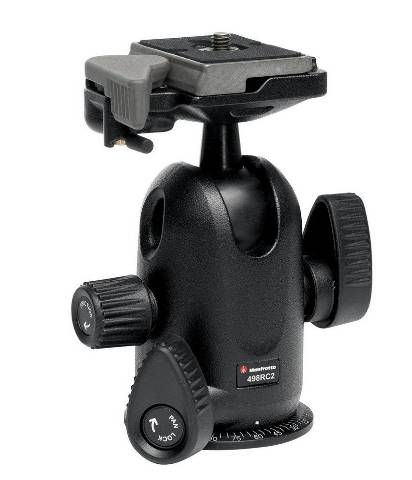
Manfrotto Ballhead
The Manfrotto Midi Ball Head with RC2 allows for the camera to be used in all orientations, has a fail-safe quick release plate and securely locks the camera position using a screw clamp type fitting.
Pan heads:
Pan heads, or pan and tilt heads, allow rotation in pan/tilt and normally flip orientations. Control of the mechanism can be by screw clamps or various gearing mechanisms. They give you fine control of the angle of the head. However, they still allow you to pan rapidly when required. These effective tripod head tend to be appropriate for many tasks. Many photographers regard them as the “general purpose” type of tripod head.
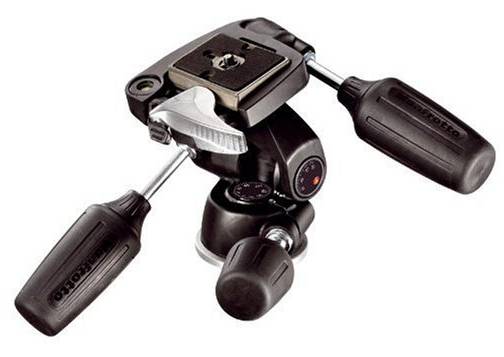
Manfrotto Pan-Tilt Head
The Manfrotto 804RC2 Basic Pan & Tilt Head with Quick Release Plate allows for flip and tilt control using two long wrist screw clamps on the top of the mechanism. You control panning by rotating the camera about the centre point on the tripod mounting below your tripod head.
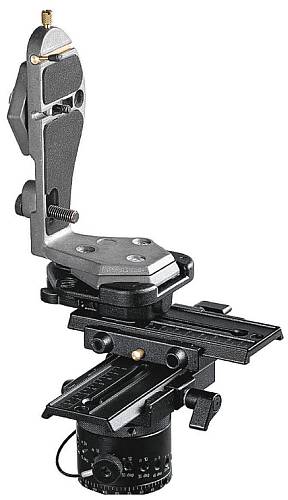
Manfrotto Panoramic Head
Panoramic heads:
For shooting a panorama you use a panoramic tripod head. You use these heads to control the rotation of the camera when making a series of photos for your panorama. The head rotates on a point of rotation in the camera. This point is at the “Entrance Pupil” of the lens. Panoramic heads (for example the Manfrotto MN-303 Virtual Reality & Panoramic Head) are used to take a series of pictures which will be stitched together to create one long picture (a panorama). Panoramic heads need to be built accurately to be effective. The fine control they give helps you prevent distortion errors between individual pictures in the panoramic series. The accuracy allows the pictures to properly overlap and ‘match’ the next image in the series. The engineering involved tends to make them expensive compared to other heads.
Gimbal head:
For supporting heavy camera/lens combinations, a Gimbal type tripod head will fit the bill. They are especially useful in wildlife photography and situations where you might need quick panning or tilting. Your camera can tilt and pan around an axis of rotation defined by the camera/lens balance. An example is the Opteka GH1 Pro Heavy Duty Gimbal Head (Supports up to 13.6 kg) seen below…
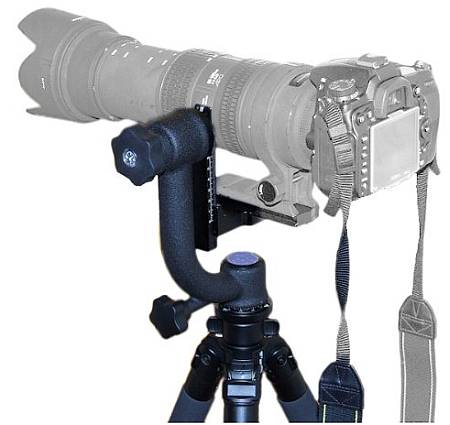
Manfrotto Gimbal Head
Macro heads:
These are highly accurate heads for the lining up of macro photographs. The shallow depth of field in macro photography makes it important to be able accurately adjust the shots so that the camera can be moved forward and backward along the optical axis of the camera to ensure that the depth of field is placed exactly where the focus is needed. The macro head requires accurate alignment of the mounting plate that the camera fits on to. It also requires accurate and highly controlled movement of the head to control the focus in the pan and tilt directions. Here is a rack example:
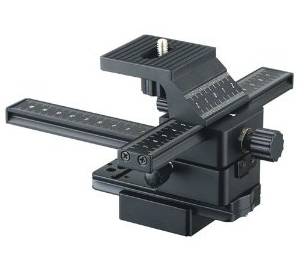
Macro Focussing Rack
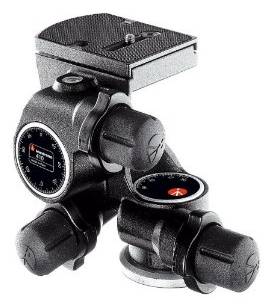
Manfrotto Junior Geared Head
The accurate and reasonably priced Profesional 4 Way Macro Focusing Rail Slider Truck for Nikon, Canon, Olympus, Pentax, Sony digital SLR (2 Year Warranty) unit (see left) should be mounted on top of the head assembly and all mounted onto the tripod. An appropriate head would be something like the Manfrotto Junior Geared Head
which is substantial enough to support the rack and a large camera/lens combination (shown left bottom) which is an excellent head for precision control of all inclinations of the camera in all focusing directions. This successful combination provides for excellent macro photography control.
Overview
All tripod heads require appropriate consideration for their use before purchasing. If you are considering a new tripod head then it is important that you factor in the ways that you intend to use it. Tripods vary in their accuracy and build quality too. You might own a great tripod, but a poor tripod head can seriously let down your photography. So it is important to consider the whole tripod, head and accessory system before you make purchases.
Photographic Glossary – Definitions, articles and resources…
tripod
Definition: Depth of Field
Definition: Optical Axis
Three Tips for Pin Sharp Shots with a Tripod
The Tripod
The Third Most Important Piece of Kit

Pingback: Photography thread size - equipment standards - Photokonnexion